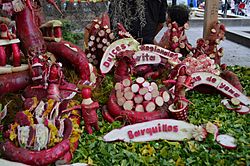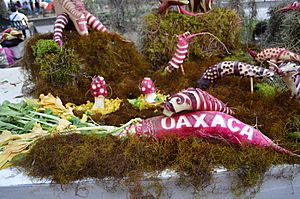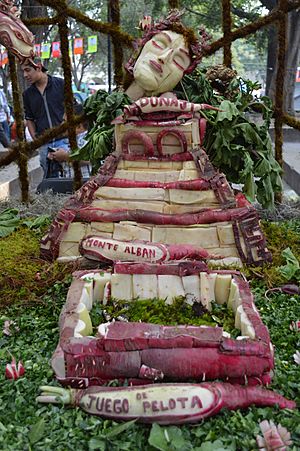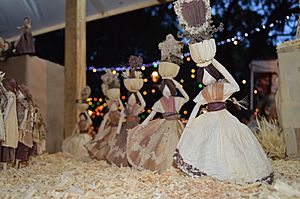Night of the Radishes facts for kids
Quick facts for kids Night of the RadishesNoche de Rábanos
|
|
|---|---|

Dulces Tradicionales Oaxaqueños entry at the 2014 Night of the Radishes
|
|
| Genre | Event |
| Date(s) | December 23 |
| Frequency | Annually |
| Location(s) | Oaxaca City |
| Inaugurated | December 23, 1897 |
| Activity | Carving of oversized radishes |
The Night of the Radishes (Spanish: Noche de Rábanos) is a special yearly event. It happens on December 23 in Oaxaca City, Mexico. People carve huge radishes into amazing scenes. These carvings compete for prizes in different groups.
This event started a long time ago. Spanish people brought radishes to Mexico. Farmers in Oaxaca already carved wood. They began carving radishes to get people's attention at the Christmas market. This market was held every December 23. In 1897, the city started a formal carving contest.
Today, the government helps grow the special radishes. They make sure there are enough for everyone. The event is very popular. Thousands of people come to see the radish art. The carved radishes don't last long. So, the displays are only up for a few hours. This means long lines for visitors! Besides radishes, there are also carvings made from corn husks and dried flowers. These often show similar themes.
The Start of the Radish Night
Radishes first came from China. Spanish friars brought them to Mexico. Over time, people ate radishes as a snack. They also carved them to decorate special dishes. In the old days, people started carving radishes with religious themes. This was for the Christmas market in Oaxaca on December 23. Priests encouraged this tradition.
The carvings were a clever way to sell radishes. Farmers used them to attract shoppers in the city square. Soon, people bought radishes not just to eat. They also bought them to make cool decorations for Christmas dinners.
A fun story tells how the event began. One year, a lot of radishes were left in the ground. In December, two friars found these forgotten radishes. They were big and had funny shapes. The friars brought them to the Christmas market. People loved these unusual vegetables. Soon, they started carving them into many different shapes and figures.
In 1897, the mayor, Francisco Vasconcelos, made it an official contest. It has been held every year since then.
In the past, a large white radish called "criollo" was used. It didn't rot easily and had unique shapes. This type of radish is not around anymore. But you can see it in a painting by Diego Rivera.
Creating Radish Masterpieces
The Night of the Radishes contest is all about carving radishes. Artists can add other small things to their scenes. Most entries are big scenes made with many radishes. Nativity scenes are very common. But over the years, artists have created many different kinds of displays.
Many scenes show daily life in Oaxaca. These include events like the Guelaguetza festival or Las Posadas parties. Other themes are Day of the Dead or local dances. You might also see Oaxacan history and stories. People also carve scenes honoring important religious figures. Sometimes, the carvings even show protest themes. Common things you'll see are people, animals, food, and crafts from Oaxaca. But you might also spot mythical creatures or even snowmen!
The radishes for the contest are special. They are grown near El Tequio Park. Farmers use lots of fertilizer and chemicals. They leave the radishes in the ground longer than usual. This makes them grow very big and have interesting shapes. These huge radishes are not good for eating. They can be up to 20 inches long and 4 inches wide. Some can weigh up to six pounds! In 2014, twelve tons of radishes were grown for the event.
Local officials watch the harvest. They give the radishes to registered artists on December 18. The radishes used today have red skin and white insides. Artists use this contrast in their designs. They might also peel the red skin to make clothes or flags for their figures. Artists usually use knives and toothpicks to carve. They cut off the long green leaves, but sometimes use them in the scenes. Even though it started from wood carving, this contest is different. Woodcarvers usually don't join because the material is so soft.
More than 100 people join the contest. They come from Oaxaca City and nearby towns. In 2014, 94 adults competed. There were also 61 youth and 50 children. Artists sign up months before the event. From December 18 to 23, they plan their scenes. They often use the natural shapes of the radishes to guide them. The actual carving happens on December 23.
There are different groups for artists. Adults can enter traditional or "free" categories. Traditional entries show nativity scenes or Oaxacan customs. Free category entries can be more modern. The main goal is to keep traditions alive. So, the biggest prize, 15,000 pesos, goes to the traditional category winner. In 2014, the Vasquez Lopez family won with "Dulces Regionales Oaxaqueños." There are also prizes for new artists. Children aged six to seventeen have their own category. This encourages young people to continue the tradition. Kids can win bicycles and school supplies.
The event also has categories for other materials. Some scenes are made from dried corn husks. Others use a dried flower called "flor inmortal." This flower dries quickly and keeps its color. These entries often have similar themes to the radish carvings.
The carved radishes don't last long. They wilt quickly after being cut. So, the whole event lasts only a few hours. It starts in the late afternoon on December 23. Stands are set up in the main square that morning. They are taken down the next morning. Visitors can see the displays in the late afternoon. Judges pick the winners around 9 PM. The radish sculptures are removed soon after.
This event is very popular. Thousands of people come to see it. Even the state governor might attend. There are special lines for visitors. One line is on a raised platform. But even with this, people might wait 4 to 5 hours to see the amazing art.
See also
 In Spanish: Noche de Rábanos para niños
In Spanish: Noche de Rábanos para niños




